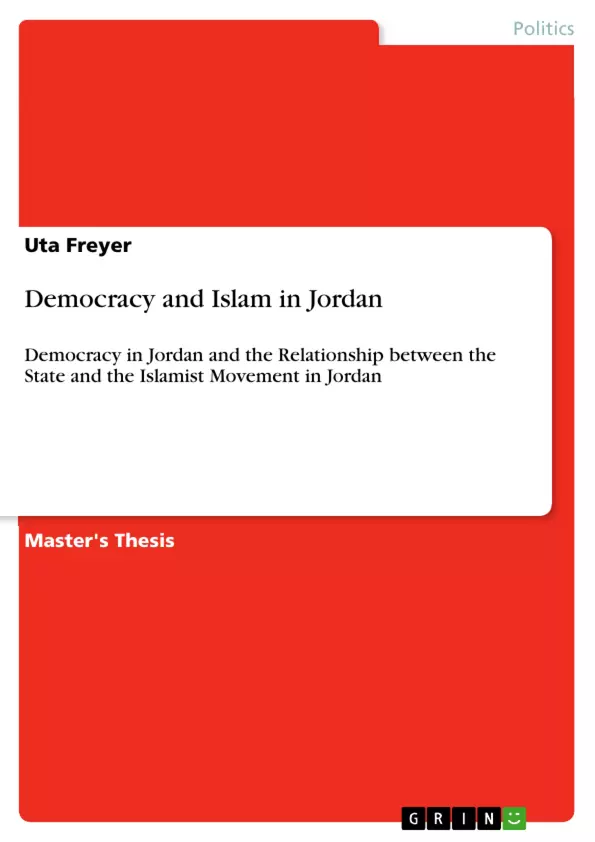This graduation project examines the influences of Islamic powers on democracy in Jordan. The Middle East is in upheaval, especially the Arabic Spring has contributed to question and reorganize society structures. While democracy and human rights take an increasing role in the global context, this seems not to be the case in the Arabic World. In the case of Jordan, the country presents itself as a constitutional monarchy within a democratic system. The constitution guarantees Western liberal democratic freedoms. Anyhow, in practice, they are rarely implemented.
The royal house strives to present the society as modern and democratic and pursues specific interests by that. Anyhow, examining the factors that define democracy, one has to raw the conclusion that society structures in Jordan are authoritarian and undemocratic. This paper examines the (un)democratic structures of Jordanian society while especially focusing on the Islamic groups in Jordan.
It analyses the influence of the Muslim Brotherhood and their corresponding political party IAF (the biggest Islamic party in Jordan) in parliament, on political reforms, on the Arabic Spring, on the role of woman in society, on the account of middle class and on the relationship of the party towards the central government. By that, it is going to become clear that IAF and Muslim Brotherhood scarcely influence political reforms in Jordan. Also in the resistance movement of the Arabic Spring in Jordan, Islamic groups had only a marginal impact. The former cooperation of the IAF with the Hashemite regime, which was based on grounds of common interests, came to rest. Experts fear an escalation with a possible radicalization of Islamic powers. Endeavours to establish more democratic structures have been disrupted.
It seems to be the most important challenge of the time of the entire Arabic World to take Islamic movements serious and to integrate them, while simultaneously pressing ahead with endeavours to democratize society.
Inhaltsverzeichnis (Table of Contents)
- Introduction
- Definitions
- Democracy
- Islam and Islamism
- Definitions
- The Jordanian State and Government and its (Non-) Democratic Structures
- History and Political Development since Establishment of the State 1922
- Political System and Democratic Structures
- The Election System
- Ethnic demography and the Middle Class
- Civic Participation
- NGOs in Jordan
- Human Rights in Jordan
- Women in Jordan
- Freedom of Opinion & Media
- Summary: Democratic Structures in Jordan
- The Relevance of External Actors for Jordan
- The Islamist Movement in Jordan
- History since the Foundation of the Muslim Brotherhood in 1945
- The Palestinian Issue
- Establishment of the Islamic Action Front (IAF)
- Islamic Action Front - Representation in Parliament
- The Party's Objectives
- Methodology and Organizational Structure
- The Relevance of the Islamic Center Charity Society (ICCS) in Jordan
- Internal Rivalries of the IAF
- Women and Women's Issues in the IAF
- Democracy as a Tool to Gain Power?
- Evolution of the Brotherhoods Discourse - From Alliance with the Government to Crisis
- The Change in the 90s and the New King Abdullah II
- The Palestinian Issue and Hamas
- Protest Movement in Jordan and the Arab Spring
- The Role of the Middle Class in Arab Spring
- History since the Foundation of the Muslim Brotherhood in 1945
Zielsetzung und Themenschwerpunkte (Objectives and Key Themes)
This graduation project examines the influences of Islamic powers on democracy in Jordan, focusing on the Islamic Action Front (IAF) and its relationship with the Jordanian government. The project aims to understand the role of Islamic groups in Jordanian politics, particularly during the Arab Spring.
- The relationship between Islam and democracy in Jordan.
- The influence of the Muslim Brotherhood and the Islamic Action Front (IAF) on Jordanian politics.
- The role of Islamic groups in the Arab Spring in Jordan.
- The (un)democratic structures of Jordanian society.
- The challenges of integrating Islamic movements into the democratic process in the Arab world.
Zusammenfassung der Kapitel (Chapter Summaries)
The project begins by defining democracy and Islamism, establishing a framework for understanding the relationship between these concepts within the context of Jordan. Chapter 2 delves into the history and political development of the Jordanian state, analyzing its democratic structures and the role of external actors. The chapter examines the election system, ethnic demography, civic participation, NGOs, human rights, women's rights, freedom of opinion, and media in Jordan.
Chapter 3 focuses on the Islamist movement in Jordan, exploring the history of the Muslim Brotherhood and the establishment of the Islamic Action Front (IAF). It analyzes the IAF's representation in parliament, its objectives, and its internal structure. The chapter examines the role of the Islamic Center Charity Society (ICCS) in Jordan, internal rivalries within the IAF, women's issues, and the IAF's perspective on democracy.
The project then moves on to discuss the evolution of the Muslim Brotherhood's discourse, highlighting the shift from alliance with the government to crisis. The chapter examines the changes brought about by King Abdullah II, the impact of the Palestinian issue and Hamas, and the role of Islamic groups in the Arab Spring in Jordan. The final section of the chapter explores the role of the middle class in the Arab Spring.
Schlüsselwörter (Keywords)
This research project explores key concepts such as democracy, Islamism, the Muslim Brotherhood, the Islamic Action Front (IAF), the Arab Spring, Jordanian politics, political reforms, societal structures, and the relationship between the state and Islamic groups in Jordan.
- Quote paper
- Uta Freyer (Author), 2017, Democracy and Islam in Jordan, Munich, GRIN Verlag, https://www.grin.com/document/366026



